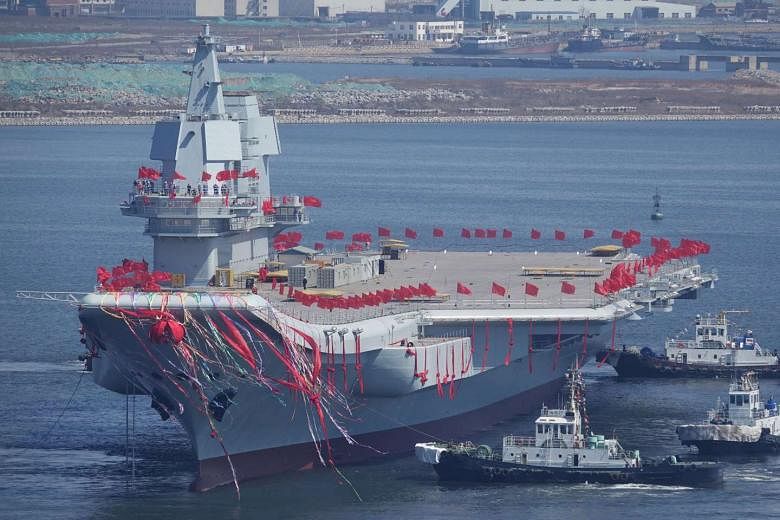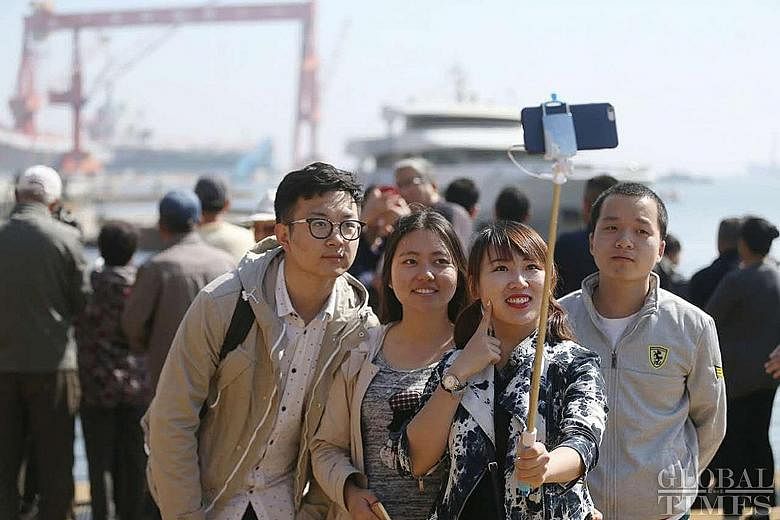BEIJING • China's first domestically built aircraft carrier slipped into the sea for the first time yesterday, after days of publicity celebrating the impending launch as a milestone in President Xi Jinping's drive to extend China's military reach far beyond its shores.
Senior military and government officials watched as a champagne bottle was smashed on the bow and as the 315m grey hull of the carrier eased into the water at Dalian, a north-eastern port, Chinese military media reported.
The ship, festooned with red national flags and banners, then stopped next to the dock. It is far from ready for operations, but the launch "signified a major stage of progress of our country's indigenous design and construction of aircraft carriers", a People's Liberation Army (PLA) news bulletin said.
It said the carrier would undergo more testing and fitting of equipment before trials in the water. It is not expected to enter service until 2020. Defence analysts at military- affiliated research groups have told state media that the country needs at least three more such carriers.
The navy is at the heart of President Xi's plans to modernise and overhaul the PLA. The launch came three days after the 68th anniversary of the founding of the PLA Navy on Sunday.
In addition to aircraft carriers, China has been building other vessels that could support and shield them on missions, said Professor Andrew Erickson at the United States Naval War College, and editor of a new book on Chinese naval shipbuilding.
"China is building a blue-water navy for the long term: not just the carriers themselves, but the auxiliary ships to supply them and the warships to protect them," he said in an e-mail.
Other ships built or under construction include a new type of supply vessel, as well as four cruisers suited for escorting a carrier, Mr Erickson said.
Even so, the relatively modest size and capabilities of the new carrier suggest that China is modernising and expanding its naval forces in a step-by-step way, avoiding risky technological leaps, experts have said.
The new carrier has a more advanced weapons systems than the Liaoning, said Mr Ni Lexiong, director of the Shanghai University of Political Science and Law's Sea Power and Defence Policy Research Institute.
The ship will accommodate more J-15 fighter jets, carry China's most advanced S-band radar and feature four batteries of HQ-10 short-range air-defence missiles, Mr Ni said.
"It signals the PLA Navy's growing capabilities, which were achieved at a fast pace," he said.
But China's two aircraft carriers are no match in size, power and endurance for those of the US Navy, which keeps 10 carriers and has two under construction. US President Donald Trump said last month that he would strengthen the navy.
The launch of China's new carrier signals "the rise and growth of overall national power", Chinese naval expert Li Jie told China's Science and Technology Daily this month.
But Mr Li tried to douse any sense of triumphalism.
"Although we've made big strides, it can't be said that we have the technology to surpass British and French aircraft carriers," Mr Li said. Mastering carriers, he added, "was not as easy as we imagined".
Both its carriers use decks with "ski jump"-shaped launch platforms to boost planes into the air, a technique that is simpler, though less powerful, than the catapult method used by American carriers.
These and other technical limits mean that China's two aircraft carriers will not be able to range out to sea for as long as American carriers, nor will the jets that fly from them be able to carry as much fuel and munitions as American carrier fighters.
They will be better suited to displays of power within the region, especially the disputed South China Sea, rather than long-term missions far from their base.
"With each new aircraft carrier, China is sending a signal that it has no peer among its neighbours," said Dr Patrick Cronin, the senior director of the Asia-Pacific Security Programme at the Centre for a New American Security in Washington.
China is entangled in maritime disputes with Japan, Vietnam, the Philippines and other Asian nations.
Japan's newest helicopter carrier, Kaga, which is 248m long, entered service last month, joining the 249m-long Izumo and two smaller Hyuga-class helicopter destroyers. Military experts have called the Kaga and Izumo, Japan's two biggest warships since World War II, quasi aircraft carriers.
NYTIMES, BLOOMBERG



